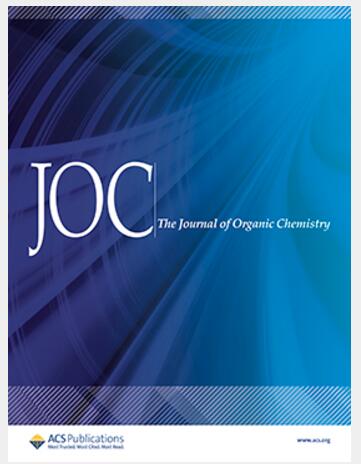Solvent- and Proton-Responsive Optical Properties of Donor-Acceptor-Type Thieno[2,3-h]isoquinoline-Based Aromatic Imides.
IF 3.6
2区 化学
Q1 CHEMISTRY, ORGANIC
引用次数: 0
Abstract
Thieno[2,3-h]isoquinoline-based aromatic imide was designed as a fundamental scaffold to modify the electronic structure of aromatic imides. Utilizing the reactivity of the thiophene unit, methoxyphenyl and N,N-dimethylaminophenyl groups were introduced into the scaffold (1 and 2, respectively), and their optical and electrochemical properties were investigated. 1 and 2 exhibited solvent-dependent fluorescence, showing linear correlations between their emission maxima and the solvent polarity parameter ET(30). 2 displayed greater sensitivity to solvent polarity than 1, owing to the stronger electron-donating nature of the dimethylamino group relative to the methoxy group. Protonation of the pyridine units in 1 and 2 led to the formation of pyridinium ions, resulting in red-shifted absorption bands. Further protonation of the dimethylamino group in 2 disrupted the donor-acceptor electronic structure, leading to blue-shifted absorption and fluorescence bands. These findings highlight the potential of the thieno[2,3-h]isoquinoline-based aromatic imide scaffold as a versatile platform for modulating the electronic structure of the aromatic imides via diverse aryl substitutions and protonation.供体-受体型噻吩[2,3-h]异喹啉芳香亚胺的溶剂和质子响应光学性质
噻吩[2,3-h]异喹啉基芳香亚胺被设计为修饰芳香亚胺电子结构的基本支架。利用噻吩单元的反应性,将甲氧基苯基和N,N-二甲氨基苯基分别引入到支架中(1和2),并研究了它们的光学和电化学性质。1和2表现出溶剂依赖的荧光,它们的发射最大值与溶剂极性参数ET呈线性相关(30)。由于二甲氨基相对于甲氧基具有更强的给电子性质,2对溶剂极性的敏感性高于1。1和2中的吡啶单元的质子化导致了吡啶离子的形成,导致了红移的吸收带。2中二甲氨基的进一步质子化破坏了供体-受体电子结构,导致蓝移吸收和荧光带。这些发现突出了噻吩[2,3-h]异喹啉基芳香亚胺支架作为一个通用平台的潜力,可以通过不同的芳基取代和质子化来调节芳香亚胺的电子结构。
本文章由计算机程序翻译,如有差异,请以英文原文为准。
求助全文
约1分钟内获得全文
求助全文
来源期刊

Journal of Organic Chemistry
化学-有机化学
CiteScore
6.20
自引率
11.10%
发文量
1467
审稿时长
2 months
期刊介绍:
Journal of Organic Chemistry welcomes original contributions of fundamental research in all branches of the theory and practice of organic chemistry. In selecting manuscripts for publication, the editors place emphasis on the quality and novelty of the work, as well as the breadth of interest to the organic chemistry community.
 求助内容:
求助内容: 应助结果提醒方式:
应助结果提醒方式:


